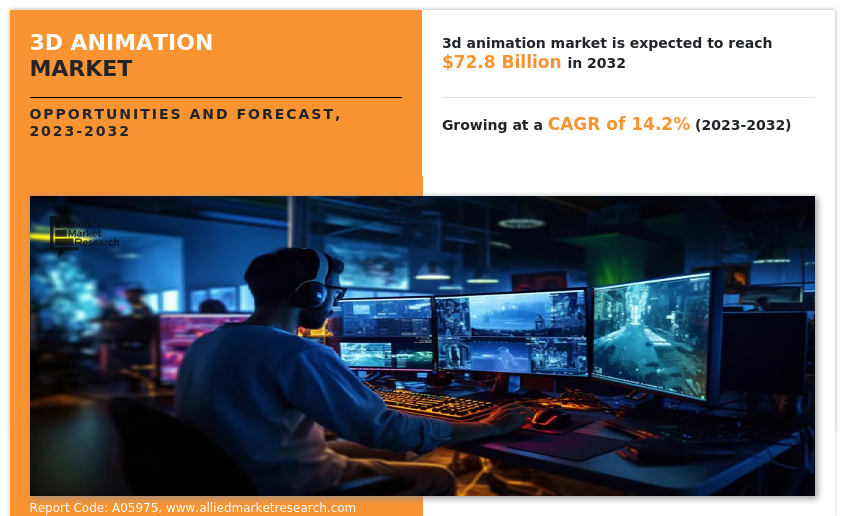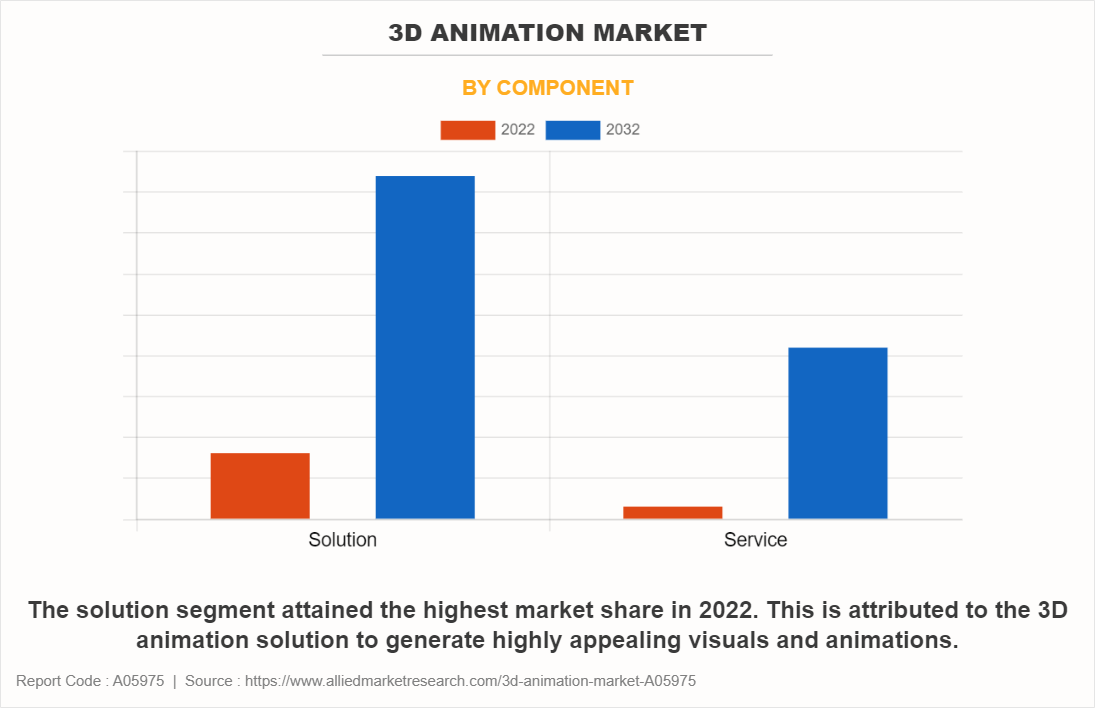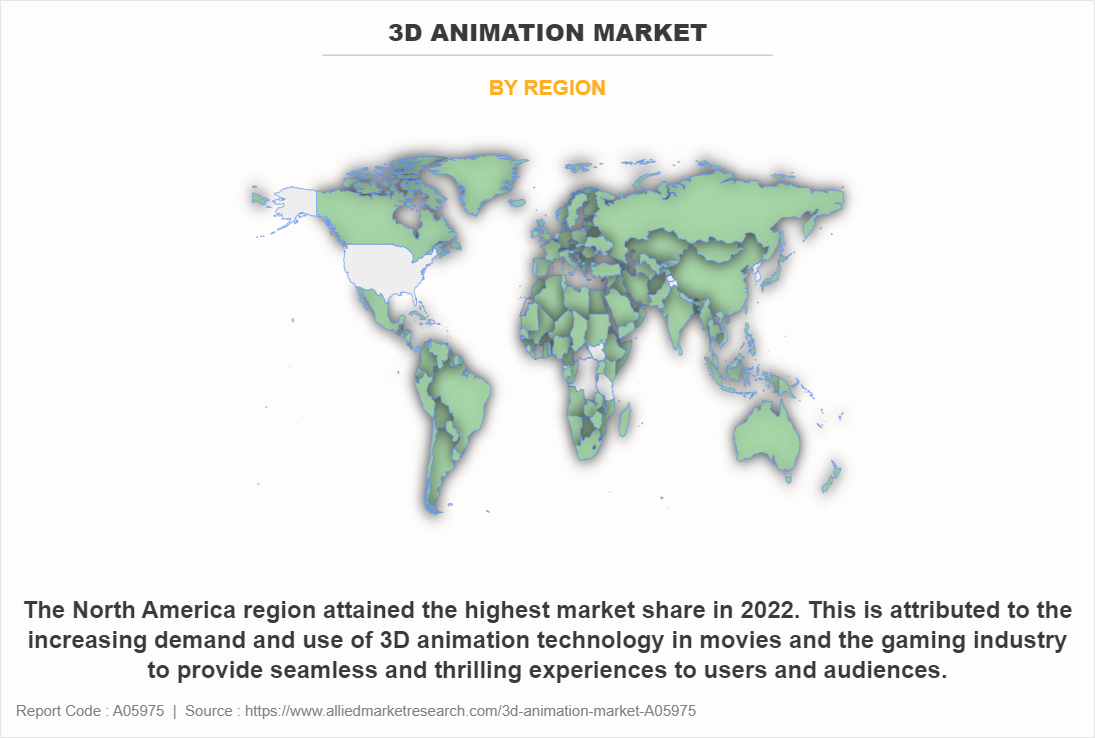3D Animation Market Statistics, 2032
The global 3D animation market size was valued at $19.5 billion in 2022, and is projected to reach $72.8 billion by 2032, growing at a CAGR of 14.2% from 2023 to 2032.
3D animation is the process of creating moving images in a three-dimensional digital environment. In addition, it involves creating characters, objects, and scenes in a three-dimensional space. These 3D models can be manipulated and animated to produce life-like movements and realistic visual effects. The key factors that drive the growth of the 3D animation market share include an increase in use of visual effects in movies, a rise in demand for high-quality content by consumers, and the adoption of cloud for animation.

3D animation technology helps in assisting filmmakers to create aesthetically sound special effects in movies. This has resulted in an increase in demand for 3D animators and VFX professionals possessing the necessary skills to provide this service. Moreover, due to 3D animation technology availability, film directors can transform their ideas into film versions. This is increasing demand for 3D animation technology in both high-budget films and low-budget films.
Furthermore, the COVID-19 epidemic has sparked an increase in virtual and online experiences, which fueled the market for 3D animation software. Industries including movies, gaming, and virtual events significantly relied on 3D animations to attract audiences because there were few opportunities for actual gatherings. Additionally, remote work arrangements have pushed companies to spend money on 3D animation tools for efficient visual product demos and communication. Moreover, real-time rendering, motion capture integration, virtual production techniques, and cloud-based 3D animation tools are among the prominent trends shaping the 3D animation software market.
The report focuses on growth prospects, restraints, and trends of the 3D animation market analysis. The study provides Porter’s five forces analysis to understand the impact of various factors, such as bargaining power of suppliers, competitive intensity of competitors, threat of new entrants, threat of substitutes, and bargaining power of buyers, on the 3D animation market.
Segment Review
The 3D animation market is segmented on the basis of component, deployment mode, technology, industry vertical, and region. In terms of components, the market is bifurcated into solutions and services. By deployment mode, the market is bifurcated into on-premises and clouds. By technology, the market is categorized into 3D modelling, motion graphics, 3D rendering, visual effects and others. Based on industry vertical, it is divided into retail, BFSI, transportation, hospitality, government and others. On the basis of region, it is analyzed across North America, Europe, Asia-Pacific, and LAMEA.

On the basis of industry vertical, media and entertainment segment is dominating the market due to the increasing use and demand for 3D animation technology in movies, OTT series, and video games. Moreover, the healthcare & life science segment will likely dominate the market by 2032 due to increasing demand for biologics.
On the basis of region, North America dominated the 3D animation market in the year 2022. This is because of the increasing demand and use of 3D animation technology in movies and the gaming industry to provide seamless and thrilling experiences to users and audiences. Moreover, the Asia-Pacific region is the growing region in the 3D animation market as a large volume of movies are made in the Asia-Pacific region particularly India and China which is driving the growth of the 3D animation market. In addition, online gaming stream activities are also growing in the Asia-Pacific region due to a large network of internet connectivity across a large population in the Asia-Pacific region which is propelling the growth of 3D animation industry.

The key players profiled in the 3D animation in ICT market analysis are Adobe Systems Inc., Autodesk Inc., Newtek Inc., Pixologic Inc., Corel Corporation, The Foundry VisionMongers Ltd., Maxon Computer, NVIDIA Corporation, SideFX Software, and Zco Corporation. These players have adopted various strategies to increase their market penetration and strengthen their position in the 3D animation industry.
Top Impacting Factors
Increase in Use of Visual Effects in Movies
The rise in demand for 3D effects in movies by the audience is driving the growth of this market. VFX and 3D animation technologies create visually stunning and lifelike moments for the audience, thus enhancing the overall cinematic experience. This realism is crucial for genres like fantasy, science fiction, and superhero films. In addition, filmmakers can now bring previously impossible worlds, creatures, and events to life. This creative freedom allows for unique storytelling and imaginative narratives. Furthermore, 3D animation and VFX are helpful in recreating historical settings, ancient civilizations, and past eras authentically in today’s era. This technology is helping filmmakers to transport audiences to different time periods.
In addition, 3D animation allows for the creation of fantastical characters, creatures, and monsters, making them more believable and engaging for the audience. Moreover, high-quality VFX and 3D animation requires initial investment, but they are proving to be more cost-effective than building elaborate physical sets and using practical effects, especially for large-scale scenes and complex environments. In addition, VFX and 3D animations are being used in VR cinema to provide them with unusual experiences, through immersive and interactive storytelling in a 360-degree environment. Therefore, all these factors are driving 3D animation market growth for the forecast period.
Rise in Demand for High-quality Content by Consumers
The increasing visual satisfaction growth of today’s generation and population is escalating the growth of the 3D animation market. High-quality 3D animation enhances blockbuster films, creating visually stunning special effects, lifelike characters, and immersive worlds. Consumers now expect cinematic experiences with seamless integration of real footage and CGI elements. In addition, High-quality 3D animation technology in video games allows for the creation of intricate, realistic game environments. Gamers demand lifelike graphics and smooth animations, leading to the integration of advanced animation techniques in game development.
Furthermore, consumers seek immersive VR and AR experiences. High-quality 3D animations enhance these immersive environments, making virtual worlds more believable and engaging. VR games, educational apps, and simulations benefit from realistic animations. Moreover, brands are using high-quality 3D animations in advertisements to create memorable campaigns. From product visualizations to creative storytelling, animations grab consumer attention and leave a lasting impression. Therefore, all these factors will propel the market growth for 3D animation technology in the forecast period.
Moreover, in August 2022, NVIDIA Corporation launched a new range of tools and features for its Omniverse platform, for building and connecting metaverse worlds based on universal scene description (USD). The expansion of Omniverse offers a number of AI-powered tools and features that give designers, programmers, and engineers the ability to create virtual worlds and content more quickly than ever before. These tools and features also enable more seamless integration with the top 3D programs of the day, such as PTC Creo, SideFX Houdini, Unity, and products from the Siemens Xcelerator platform.
Adoption of Cloud for Animation
The growing adoption of cloud for utilization in the 3D animation technology is driving the growth of 3D animation market. Cloud-based solutions offer scalable resources, allowing animation studios to scale up and down based on project requirements. This flexibility eliminates the need for significant upfront investments in hardware and infrastructure. Furthermore, cloud-based platforms facilitate collaboration among teams located in different parts of the world. Animators, artists, and other professionals can work on the same project simultaneously, enhancing productivity and creativity.
Moreover, Cloud-based solutions eliminate the need for large capital expenditures on expensive hardware and software licenses. Animation studios can use subscription-based models, paying for the most cost-effective requirement. Therefore, all these factors will escalate the market growth for 3D animation technology in the forecast period.
Market landscape and trends
The expansion of 3D animation industry is driven by various trends such as the integration of 3D animation in virtual reality (VR) and augmented reality (AR) applications are becoming more widespread. Industries like gaming, real estate, healthcare, and education are utilizing 3D animations for immersive experiences. Streaming platforms like Netflix, Hulu, and Disney+ are investing heavily in original 3D animated content. This trend is expected to continue, with a focus on diverse storytelling and unique animation styles.
Furthermore, the gaming industry is a significant driver for the 3D animation industry. With the increasing popularity of esports and high-quality graphics in video games, the demand for skilled animators and advanced animation technologies is on the rise. Moreover, apart from entertainment, sectors like automotive, manufacturing, and aerospace are utilizing 3D animations for simulations, training, and prototyping. This diversification of the market is opening new opportunities for 3D animation companies and will increase 3D animation market size in the future.
Regional Insight
North America:
North America leads the 3D Animation Market, driven by its prominent entertainment industry and the presence of major animation studios such as Pixar, DreamWorks, and Disney. The region's robust demand for visual effects (VFX) in film production, particularly for high-budget movies, boosts market growth. Additionally, advancements in technology, such as real-time rendering and cloud computing, have streamlined animation workflows, further solidifying North America's dominance in the industry.
Europe:
In Europe, countries like the UK, France, and Germany contribute significantly to the 3D animation market due to their well-established creative sectors. Europe is known for fostering talent with its many training centers focused on animation. The region’s gaming industry is also a major contributor to market growth, with increasing use of 3D animation in video game development. Government support for digital media and creative industries continues to drive innovation and expansion in this region.
Asia-Pacific:
The Asia-Pacific region is experiencing the fastest growth in the 3D Animation Market. Countries like China, Japan, and India are emerging as major players. India has become a global outsourcing hub for animation services, offering cost-effective solutions for studios worldwide. Japan, with its strong anime culture and gaming industry, remains a key market driver. The region is also seeing growing adoption of virtual reality (VR) and augmented reality (AR), where 3D animation plays a critical role, further driving market growth.
Middle East & Africa:
The Middle East & Africa region is still in its early stages of growth in the 3D animation market. However, countries like the UAE and South Africa are making notable strides, with governments launching initiatives to boost the media and entertainment sectors. Animation is increasingly being used in education, advertising, and entertainment in these regions, signaling growing market potential.
Latin America:
In Latin America, countries such as Brazil and Mexico are seeing an increase in local animation studios and production capabilities. These countries are participating more actively in international co-productions, and demand for localized content in entertainment, advertising, and e-learning is rising. This growing interest in animation is positioning Latin America as an emerging market for 3D animation.
Key Industry Development
Recent product launches in 3D animation market
In April 2022, Maxon computer launched Maxon One Platform that integrates all its products, namely cinema 4d, redshift, red giant, universe, forger, and Zbrush into one combined unit. In addition, it updated features of different products in the Maxon One offering to provide seamless experience to the users.
In September 2022, Autodesk Inc. launched Maya Creative for flexible and affordable artist workflows to lower the entry hurdle for artists at smaller facilities to increase accessibility of content development. For creation of movies, television shows, and video games, it offers robust modeling, animation, rigging, and rendering tools.
Recent acquisition in 3D animation market
In November 2022, Alludo acquired Nitro Software Limited, a publicly traded global software as a service (SaaS) leader in PDF software, document management, and electronic signatures at a price of A$2.00 cash per share. It was guided by Kirkland & Ellis, an American multinational law firm.
Key Benefits for Stakeholders
This report provides a quantitative analysis of the market segments, current trends, estimations, and dynamics of the 3D animation market forecast from 2022 to 2032 to identify the prevailing market opportunities.
Market research is offered along with information related to key drivers, restraints, and opportunities of 3D animation market outlook.
Porter's five forces analysis highlights the potency of buyers and suppliers to enable stakeholders to make profit-oriented business decisions and strengthen their supplier-buyer network.
In-depth analysis of the 3D animation market segmentation assists in determining the prevailing 3D animation market opportunity.
Major countries in each region are mapped according to their revenue contribution to the global market.
Market player positioning facilitates benchmarking and provides a clear understanding of the present position of the market players.
The report includes an analysis of the regional as well as global 3D animation market trends, key players, market segments, application areas, and market growth strategies.
3D Animation Market Report Highlights
| Aspects | Details |
| Market Size By 2032 | USD 72.8 billion |
| Growth Rate | CAGR of 14.2% |
| Forecast period | 2022 - 2032 |
| Report Pages | 495 |
| By Component |
|
| By Deployment Mode |
|
| By Technology |
|
| By Industry Vertical |
|
| By Region |
|
| Key Market Players | Newtek Inc. (Vizrt), The Foundry Visionmongers Ltd., Adobe Systems Inc., Pixologic Inc, Zco Corporation, NVIDIA Corporation, Corel Corporation, SideFX Software Inc., Autodesk Inc., Maxon Computer |
Analyst Review
As per the insights of the top-level CXOs, the adoption of 3D animation technology has a profound impact on the ICT sector revolutionizing various aspects of the industry. 3D animation technology accounts for numerous uses in different industries such as film & television, gaming, architecture & real estate, medical & healthcare, education, and others. Technology is useful in the development of lifelike characters, creatures, and environments in movies and TV shows. In addition, the technology is used for game development to enhance character design, animation, and game environment. Furthermore, 3D animation technology assists in creating virtual tours of buildings and spaces before construction, thus helping architects and clients. In addition, 3D animations visualize complex medical procedures, anatomy, and drug interactions for educational purposes. Moreover, 3D animations make learning interactive by visualizing complex concepts, historical events, and scientific processes.
The CXOs further added that market players are adopting strategies like product upgradation to enhance their services in the market and improve customer satisfaction. For instance, in August 2023, NVIDIA Corporation upgraded their NVIDIA Omniverse platform, to offer new applications and services to optimize and enhance 3D pipelines, with open USD framework and generative AI. In addition, some companies adopted an acquisition strategy. For Instance, in January 2021, Maxon Computer acquired its Japanese distributor business to establish Maxon Computer KK office in Japan and to strengthen its relationship with the Japanese market and provide direct support for the Cinema 4D, Red Giant and Redshift Artistic Community. Therefore, such strategies are expected to boost the growth of the 3D animation market in the upcoming years.
The key players profiled in the 3D animation in ICT market analysis are Adobe Systems Inc., Autodesk Inc., Newtek Inc., Pixologic Inc., Corel Corporation, The Foundry VisionMongers Ltd., Maxon Computer, NVIDIA Corporation, SideFX Software, and Zco Corporation. These players have adopted various strategies to increase their market penetration and strengthen their position in the 3D animation industry.
The expansion of 3D animation market is driven by various trends such as the integration of 3D animation in virtual reality (VR) and augmented reality (AR) applications are becoming more widespread. Industries like gaming, real estate, healthcare, and education are utilizing 3D animations for immersive experiences.
3D animation technology accounts for numerous uses in different industries such as film & television, gaming, architecture & real estate, medical & healthcare, education, and others. Technology is useful in the development of lifelike characters, creatures, and environments in movies and TV shows.
North America is the largest regional market for 3D Animation.
The estimated industry size of 3D animation market is projected to reach $72,827.47 million by 2032 growing at a CAGR of 14.2% from 2023 to 2032.
Adobe Systems Inc., Autodesk Inc., Newtek Inc., Pixologic Inc., Corel Corporation, The Foundry VisionMongers Ltd., Maxon Computer, NVIDIA Corporation, SideFX Software, and Zco Corporation.
Loading Table Of Content...
Loading Research Methodology...



